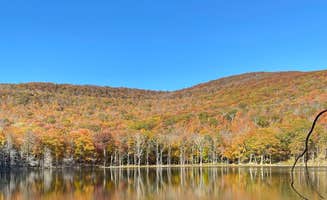Primitive camping near Great Barrington, Massachusetts occurs primarily in the forested hills at elevations between 1,000-2,500 feet where temperature variations can exceed 25°F between day and night, even in summer months. The region spans four states with camping sites distributed across the Taconic Mountains and southern Green Mountains. Most dispersed sites require self-sufficiency with no facilities and follow strict pack-in, pack-out regulations.
What to do
Hike accessible trails: Several camping spots provide direct access to trail networks. At Taconic Hereford Multiple Use Park, campers appreciate the proximity to hiking trails. "99% of people don't even know this area exists. If you want a quiet piece of beautiful forest to truly rough it and go camping for a few days, then this is what you have been looking for. Less then 10 min drive from town, but hiking in and finding a suitable place to make camp has the feeling of the wild, with the safety of having full cell service."
Fish in nearby streams: Most primitive sites sit within walking distance of waterways. At Sage's Revine, visitors can camp "Near non-potable stream, no fires allowed, bathroom is fine, bear boxes available. 50 feet between platforms. Right over the border of CT into MA on the Appalachian Trail."
Experience seasonal wildlife viewing: The diverse ecosystem supports various wildlife viewing opportunities depending on season. Dawn and dusk provide optimal viewing times, particularly in less trafficked areas. Morning hikes offer the best chance to spot local bird species.
What campers like
Natural water access: Multiple sites feature stream or lake proximity. At Echo Lake, campers enjoy "tent sites around the whole lake with fire pits and 1 lean-to site at the end of the trail when you first arrive at the lake. The sites are relatively flat and well shaded with trees. Note, it can get swampy near the edge of the lake so you may want to bring bug spray."
Secluded camping spots: Most primitive sites around Great Barrington offer significant privacy between camp areas. "We camped on the hill with a beautiful view of the whole lake and breeze," noted one Echo Lake visitor, highlighting the elevated camping options that provide both views and separation from other sites.
Forest coverage: Most sites feature extensive tree cover providing natural shade. "The road itself was in great condition though," notes one camper about NFR 273 Dispersed Camping Spot, adding "After what was very quiet and a peaceful place to be." Another visitor noted: "At least a dozen spots, some very spacious. Only crashed for 1 night but will be coming back to spend a few, this area was excellent!"
What you should know
Limited amenities: Most dispersed sites require complete self-sufficiency. Many locations have no toilets, trash service, or potable water. One camper at Jug End Dispersed noted: "Great spot, I have section hiked the majority of the east coast AT and this is in my top 10 spots to stay at. Trash cans, but carry out is preferable."
Site availability challenges: Many areas fill quickly during peak seasons. Weekday arrivals significantly improve chances of securing preferred spots. Arrive before noon for best site selection, particularly during fall foliage season.
Road conditions vary: Access roads to primitive sites often remain unmaintained. Four-wheel drive vehicles may be necessary after rain events. A camper at NFR 273 noted: "The entrance to the road had a sign that said 'road closed ahead'. We chanced it and was able to find a really nice open spot right before the road closure. Was a great spot!"
Site-specific fire regulations: Fire regulations vary significantly between sites. Some allow fires in established rings only, while others prohibit fires entirely. Always verify current fire restrictions before arrival.
Tips for camping with families
Choose sites with natural boundaries: Look for camping spots with natural features that create contained play areas. At Echo Lake, "This campground was my first backpacking trip and it was perfect! It does get a little crowded later in the day so you may have to share space with others and it can be a little noisy at night."
Plan for insect protection: Wooded areas typically experience significant insect activity, particularly in warm months. Multiple layers of protection recommended. One camper at NFR 273 noted: "A LOT of bugs due to dense wooded surroundings. The bugs seems to be unbothered by the bug spray as well."
Consider proximity to emergency services: Cell service varies widely throughout the region. Taconic Hereford offers better connectivity than more remote options. "This spot is easy to find and access, and had decent ATT service. There's only a few spots, and the road is narrow with not much turnaround room," notes one visitor.
Water safety planning: Many sites sit near water features requiring supervision. Establish clear boundaries around water features, particularly at lakeside camping areas like Echo Lake.
Tips from RVers
Size limitations: Most dispersed camping areas have limited space for large vehicles. At Taconic Hereford Multiple Use Park, a reviewer cautions: "I wouldn't recommend for trailers or RVs."
Road clearance concerns: Many access roads feature low-hanging branches or narrow passages. Verify road conditions before attempting access with larger vehicles. At NFR 273, one camper noted they "had to drive about 4 miles down the dirt road to find a suitable spot. Many pull offs but a lot were too wet for my van and I was afraid of getting stuck."
Limited turn-around space: Many forest roads lack adequate turning areas for larger vehicles. Scout ahead before committing to narrow access roads, particularly during wet conditions when soft shoulders may cause problems.



